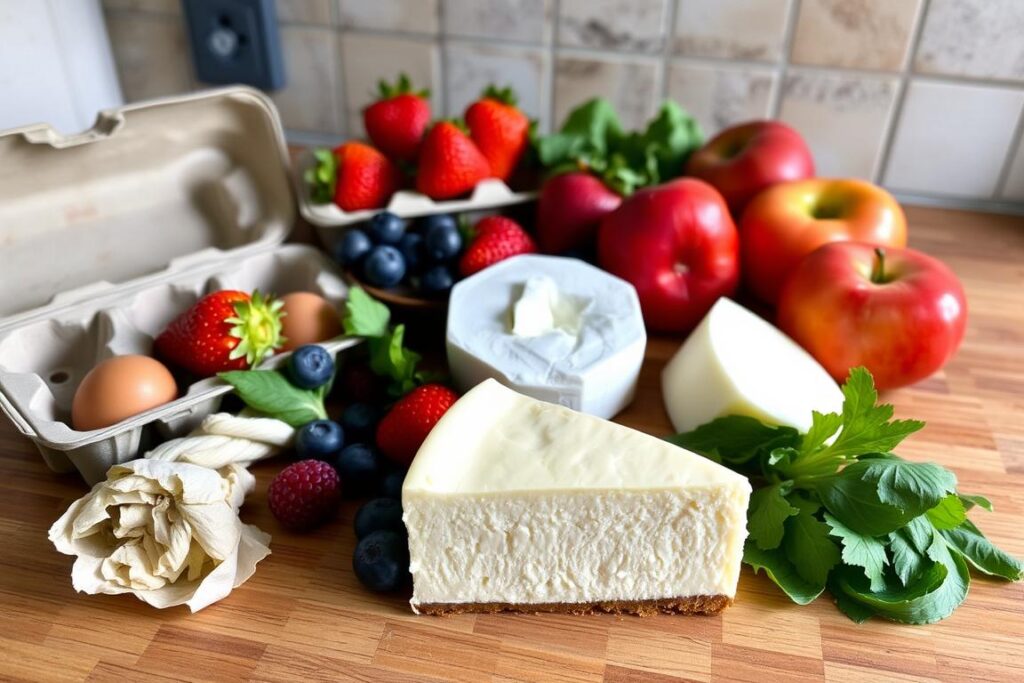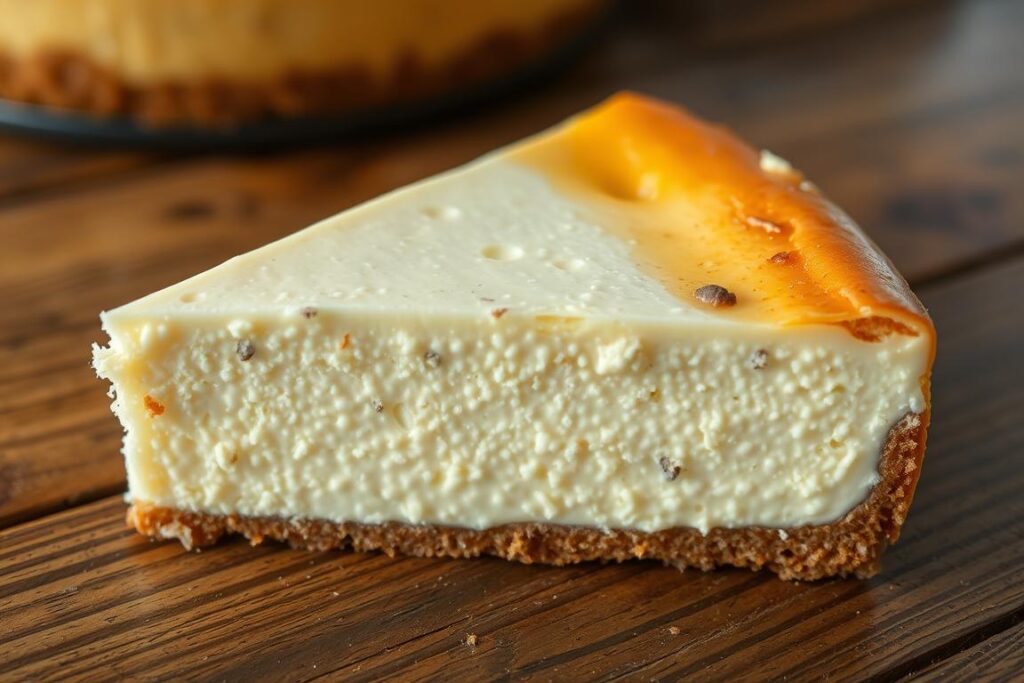Ever thought about eating cheesecake left out overnight? It’s a question many face, especially with food safety in mind. Cheesecake, with its creamy texture and rich ingredients, needs careful handling. This article explores the dangers of eating cheesecake left out, shedding light on food safety.
Key Takeaways
- Cheesecake is a perishable food that requires refrigeration.
- Food safety standards highlight the risks of leaving dairy products out for extended periods.
- Understanding the factors that make cheesecake unsafe after being left out can prevent foodborne illness.
- Follow best storage practices to ensure a safe and enjoyable dessert experience, integrating advice from sources like Amalia Recipes.
- Recognizing signs of spoilage in cheesecake is essential for safe consumption.
Understanding Food Safety for Perishable Foods
Food safety is key to keeping us healthy, especially with foods that spoil fast like dairy. Knowing the rules from food safety groups helps avoid sickness. If we don’t handle and store food right, it can go bad.
Items like cheesecake need careful fridge use and timing. Cream cheese, a cheesecake mainstay, grows bacteria fast when left out. Remember, bad food can cause serious health problems. So, it’s smart to stay safe with food handling.
Keeping food in the right temperature stops contamination. Safe food practices help us and everyone else stay healthy. For more on keeping food safe, check out this guide on food safety practices.
| Perishable Foods | Recommended Storage Time | Common Risks |
|---|---|---|
| Cheesecake | Up to 2 hours at room temperature | Foodborne illnesses |
| Cream Cheese | Up to 2 hours at room temperature | It can spoil quickly, increasing health risks |
| Milk | 2 hours outside refrigerator | Risks of bacterial contamination |
| Cooked Dairy Products | 2 hours outside refrigerator | Foodborne pathogens |
What Makes Cheesecake a Perishable Food?
Cheesecake is a perishable food because of its ingredients. It has cream cheese, eggs, and sugar. These make it creamy and delicious but also high in moisture and protein.
This high moisture and protein content attract bacteria. If not stored right, cheesecake can spoil fast. Bacteria can grow quickly, causing foodborne illnesses.
Storing cheesecake in the fridge is key. It keeps the cheesecake safe and tasty. This way, you can enjoy it without worrying about it going bad.

Is it safe to eat cheesecake that was left out overnight?
It’s important to know if it’s safe to eat cheesecake left out overnight. Foods like cheesecake need to stay at the right temperature to avoid harmful bacteria. Leaving it out can lead to bacteria growth and health risks.
Dangers of Leaving Cheesecake Out
Cheesecake, being rich in dairy, is especially risky when not refrigerated. The USDA warns that perishable items should not stay out for more than two hours. This is to prevent bacteria growth and foodborne illness.
Bacteria Growth and Foodborne Illness
When wondering if it’s safe to eat cheesecake left out, think about the bacteria it can attract. Bacteria like Salmonella and E. Coli can grow in creamy foods like cheesecake. Even at cooler temperatures, the risk of foodborne illness increases.
Knowing these risks helps cheesecake lovers make better choices. By storing it properly, you can enjoy cheesecake without worrying about getting sick.
Importance of Temperature Control
Keeping food at the right temperature is key to food safety, especially for items like cheesecake. This dessert, full of dairy, needs careful handling to avoid foodborne illnesses and spoilage.
What is the Danger Zone?
The danger zone for food safety is between 40°F and 140°F. In this range, bacteria can grow fast, raising the risk of contamination. Cheesecake, being rich in dairy, is more likely to get contaminated if not stored right. Keeping it at the right temperature keeps it safe and fresh.
Effects of Temperature on Dairy Products
Temperature greatly affects the safety and shelf life of dairy products. Cheesecake should be kept in the fridge to keep it chilled and prevent bacterial growth. If left out, it can lose its quality and structure.
Knowing how temperature impacts dairy is crucial for food safety. The USDA recommends eating cheesecake within five to seven days of baking or buying. For more on storing cheesecake, check out this useful guide.
Recommendations for Cheesecake Storage
Storing cheesecake right is key to keeping its taste and preventing it from going bad. By following some simple steps for refrigeration and wrapping, you can make your cheesecake even better.
Best Practices for Refrigeration
Put the cheesecake in the fridge as soon as it cools down to room temperature. Try to do this within two hours of baking. Keeping the fridge at a temperature below 40°F is crucial for keeping it fresh.
The USDA says it’s best to eat refrigerated cheesecake within 5 to 7 days. This helps avoid health risks from spoilage.
Wrapping and Storing Leftover Cheesecake
Wrapping your cheesecake right can really help it last longer. Use plastic wrap to cover it tightly. This stops it from picking up smells and keeps it creamy.
Putting the wrapped cheesecake in a sealed container adds extra protection. It keeps air and contaminants out, helping to keep the cheesecake fresh and tasty for your next slice.
| Storage Method | Pros | Cons |
|---|---|---|
| Plastic Wrap | Keeps moisture, prevents odor absorption | Can be prone to tearing |
| Sealed Container | Offers excellent protection, minimizes air exposure | Requires more space in the fridge |
| Aluminum Foil | Good for temperature control | Less effective at preventing odors |
Signs of Spoiled Cheesecake
Cheesecake is tasty but needs careful checking to stay safe. Knowing when it’s gone bad helps us make smart choices about food safety. It can spoil if stored wrong or left out too long. Spotting these signs early is key to avoiding health issues.
How to Determine if Cheesecake is Still Safe to Eat
To check if cheesecake is safe, look at its smell and appearance. First, smell it; a sour smell means it’s bad. Then, check how it looks. A good cheesecake is smooth and even.
What to Look For When Evaluating Cheesecake
Here are the main signs of a bad cheesecake:
- Changes in color, like yellowing or browning.
- Texture changes, like it feels rubbery or slimy.
- Visible mold, which means it’s definitely spoiled.
These signs help you know if cheesecake is bad. It’s good to check reliable sources, like this site, for tips on keeping desserts fresh.

| Indicator | What It Means |
|---|---|
| Foul smell | Likely spoiled, do not consume |
| Discoloration | Possible spoilage, assess further |
| Mold | Do not eat, definite spoilage |
| Rubbery texture | May indicate spoilage, discard if uncertain |
Being careful about these signs helps keep food safety in mind when eating cheesecake. If you’re unsure, it’s best to throw it away. This keeps your health safe.
Common Misconceptions About Cheesecake
Many people think wrong about cheesecake, which can lead to bad practices when storing desserts. It’s key to know how cheesecake is different from other cakes. This part will clear up these wrong ideas and stress the need for safe food handling.
Can Other Cakes Be Left Out?
Some think all cakes can sit out at room temperature without harm. But, creamy cakes like cheesecake need to be kept cold. Not doing so can cause them to spoil and even make you sick. It’s important to know the right way to handle food for safety.
Understanding Other Dairy-Based Desserts
Like cheesecake, desserts like custards and cream pies are also sensitive to temperature. If they’re not kept cold, they can go bad fast and be dangerous to eat. It’s important to remember that not all desserts are the same when it comes to storage. Knowing this can help avoid food safety issues.
Conclusion
Understanding food safety is key when enjoying cheesecake and other perishable foods. Leaving cheesecake out overnight can lead to health risks. This is because bacteria can grow, posing serious threats of foodborne illnesses.
Since cheesecake has dairy, it needs proper storage. Following refrigeration best practices helps. Recognizing spoilage signs is also important.
By doing this, people can make smart choices about eating cheesecake. It’s crucial to keep safety in mind. This way, cheesecake can be enjoyed without worrying about health.
Knowing food safety rules and how to handle perishable foods makes cheesecake more enjoyable. It lets people savor it without worry. Taking these steps is essential for both safety and taste.


